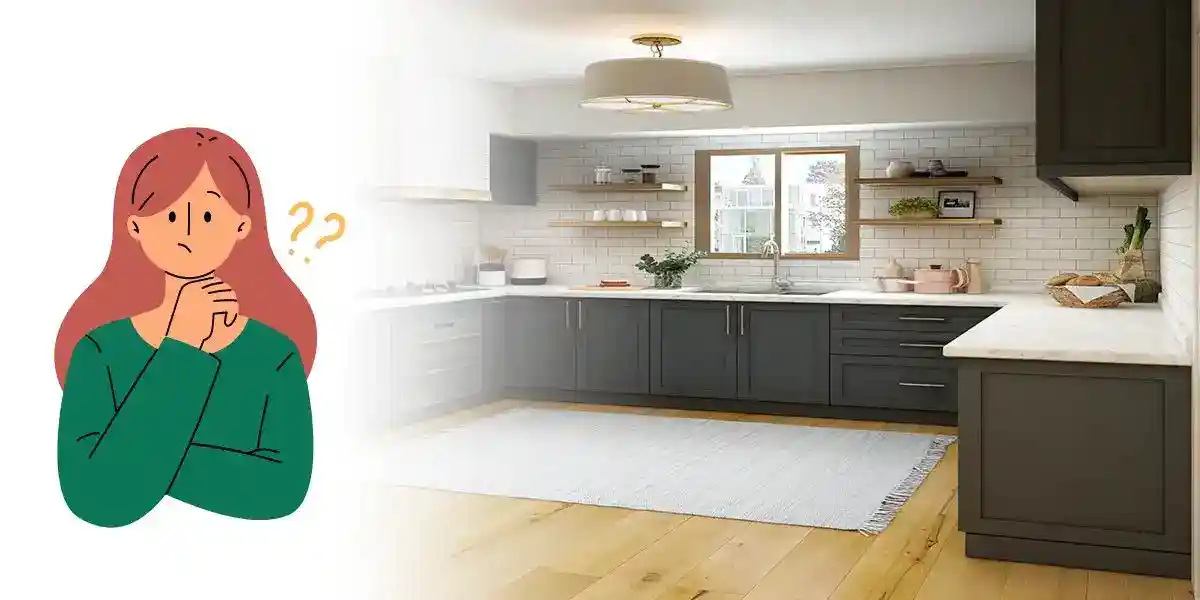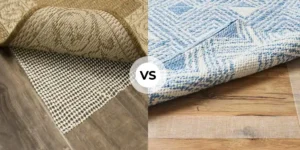Yes, you can install vinyl flooring under the appliance. But it is not safe if the appliance weighs more than 500 pounds.
That’s because each vinyl plank cannot hold more than 500 pounds (around 226-227 kg). So, putting a bulky appliance on vinyl flooring might cause a dent or mark on your vinyl flooring.
Moreover, installing vinyl flooring under appliances is against the manufacturer’s instructions.
Because the floor may fail to expand at both ends. So, this can cause damage to the floor and denting in the flooring if you do not cushion the legs of the furniture.
Secondly, it can also void your product warranty. Provided the appliance doesn’t exceed 500 pounds.
Putting vinyl flooring under appliances without considering their weight is a hazardous affair. That’s because you will spend lots of your investment fixing the damages. Which are unnecessary if you had initially considered taking preventative measures.
Thus, it is important to know if the vinyl floor can be placed under appliances before knowing how to protect it.
Is It Safe to Put a Vinyl Floor Under Appliances?
Yes, putting vinyl flooring under appliances is generally a good idea. It gives your floor a cohesive look and protects the entire surface.
But it’s not a strict rule. Some people choose not to place vinyl under appliances, especially heavy ones like refrigerators, to make them easier to move. In this case, just ensure the flooring goes up to the edges of the appliances.
It’s a personal preference, so consider your convenience and overall aesthetics.
But, it is worth noting that vinyl flooring is very sensitive to weight, temperature changes, humidity, and sharp objects. With that in mind, you must adopt different measures to keep your floor safe and improve its lifespan.
Generally, it is risky to put a vinyl floor under appliances for the following reasons:
Can Lead To Wrapping Of The Floor
Since vinyl flooring is a floating floor, any heavy appliance applied to it can disrupt the normal expansion and shifting of the floor.
Thus, it will start lifting and creating bubbles, causing the floor to wrap around and creating bumps. It can also become a tripping hazard and cause severe damage to the floor.
May Lead to Scratches, Dents, and Leave Scuff Marks Behind
The heavy appliance may scratch, dent, and leave scuff marks when being dragged across the floor.
It would be wise if you were very careful when dragging appliances onto rough surfaces. Because they can create dents and scratches on the floor due to the weight pressure and impact.
And, if the surface is rough or made out of rubber, it can also leave scuff marks on the floor. Worrying about dents and scratches would be prudent, as they could become permanent.
Secondly, dents can also trap dust and dirt. Causing humidity and moisture to reflect, resulting in severe damage.
Also See: A Guide to Remove Rubber Marks from Vinyl Flooring
Ways to Protect Vinyl Plank Flooring Under Appliances

With proper installation and preventative measures in place, you can prevent your floor from getting damaged. Consider the following before putting vinyl flooring under appliances. They include:
Walls and Cabinets Should Not Touch the Floor
When installing vinyl flooring, ensure you allow room for expansion and contraction. So that the floor can shift freely in 2D as temperatures change. This ensures that the floor does not touch the walls or cabinets to avoid the floor settling and creating bumps and lumps.
Also See: Do I Need Expansion Gaps for Vinyl Flooring? (Explained)
Glue Down the Areas Under the Appliances
Since an interlocking mechanism secures vinyl flooring, the appliance’s weight can cause lift or bubbling.
To prevent bubbling. Professionals recommend gluing the interlocking section of the planks to reduce the risk of warping. When the floor is under the weight and impact of the appliance.
Moreover, opting for a premium adhesive that will last longer and ensure better attachment is advisable.
Also See: Can a Floating Floor be Glued?
Use a Hand Truck
We advise you against dragging heavy appliances like refrigerators, cookers, and more across the floor. Instead, it would be advisable to use a hand truck.
The hand truck helps distribute the weight. Reduces the risk of denting or scratching the vinyl surface. It provides a stable and smooth platform for transporting appliances. Making the process easier on both the flooring and your back.
So, using a hand truck to move heavy appliances across the floor will reduce the cost of re-doing the entire floor in the long run.
Must See: 5 Best Ways to Protect Vinyl Flooring From Heavy Furniture (Must-Try!)
Use Forklift Straps
When moving heavy appliances over your vinyl plank flooring. Using forklift straps is a smart move. These straps help spread the weight more evenly, keeping your flooring safe from dents or damage.
Just make sure to secure the appliance properly to the forklift straps and lift it gently. Don’t drag the appliance, as it can scratch the vinyl.
Also, check for any sharp edges on the appliance and wrap them up for extra protection. By using forklift straps, you’re ensuring a smooth and damage-free move. For both your heavy appliances and your vinyl plank flooring.
Installing Furniture Pads
Furniture pads are also vital in preventing dents and scratches on your flooring. They work by creating a strong shield between the furniture and the floor. To protect the surface from dents, scratches, and scuffs.
These are the most secure and convenient ways to keep appliances in place. And protect vinyl flooring from getting damaged while doing house chores. Better yet, furniture pads are affordable. And easy to install and clean compared to other methods.
Aside from preventing dents and scratches, it prevents your vinyl flooring from discoloring. It is also a significant benefit while saving you the burden of frequent maintenance.
Do not opt for furniture pads made of rubber. Because they are made of chemicals that release them and can stain the floor over time.
Pros & Cons of Putting Down Vinyl Flooring Under Appliances
Pros
- Looks good. There is no need for transition strips.
- You don’t need to worry about adjusting the height measurement.
- Installing the floor afterward did not damage the cabinets or appliances.
- Dirt and debris can easily be removed from the entire floor.
Cons
- It will cause more damage to vinyl than concrete when water leaks.
- Warm temperatures can cause the floor to buckle or lift.
- You will have to dig under the cabinets or remove them to change the floor.
- Installing it under the cabinet voids the manufacturer’s warranty.
Read More on Vinyl Floors
- Can Mold Grow Under Vinyl Plank Flooring? (Answered)
- 5 Best Ways to Protect Vinyl Flooring From Heavy Furniture (Must-Try!)
- Do I Need Expansion Gaps for Vinyl Flooring? (Explained)
- Can You Use Pine Solution for Vinyl Flooring? (Answered!)
- Does Vinyl Flooring Fade in the Sun? (6 Ways to Prevent From Fading)





